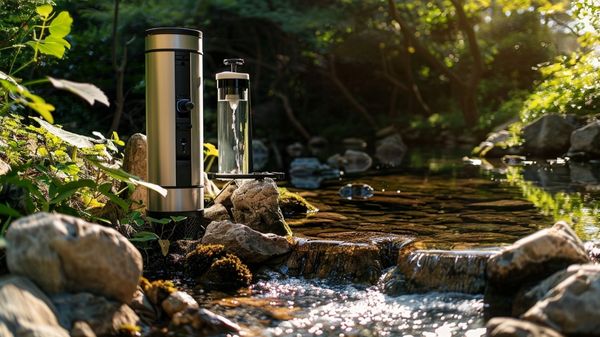Are you tired of relying on traditional water sources and looking to become more self-sufficient? Look no further! In this article, we will explore 10 reliable off grid water systems that will transform your property into a haven of sustainability.
From rainwater harvesting to hand pumps and permaculture swales, we’ve got you covered. Say goodbye to high utility bills and hello to a sense of belonging as you take control of your water supply. Let’s dive in and discover the possibilities that await you!

Key Takeaways
- Rainwater harvesting systems, such as rain barrels and permaculture swales, can provide a large supply of clean water and help conserve water and reduce utility bills.
- Hand pumps and wells offer self-sufficient water sources that can be relied upon during emergencies or in off-grid living situations.
- Cisterns and underground ponds provide large storage capacities for water and offer peace of mind with a reliable water supply.
- Aqueducts and cascade water flow systems maximize water usage, reduce reliance on electric pumps, and promote efficiency in water usage.
Rainwater Harvesting
Rain barrels provide a large supply of clean water that can be easily obtained through rainwater harvesting. This off-grid water system is an efficient and sustainable way to collect and store rainwater for various purposes.
By installing rain barrels at strategic locations around your property, you can maximize the collection of rainwater and reduce reliance on external water sources. A well-designed off-grid water system diagram can help you visualize the setup and ensure optimal functionality.
Additionally, incorporating off-grid grey water systems and a reliable off-grid water filtration system can further enhance the efficiency and safety of your rainwater harvesting system.
With these components in place, you can confidently rely on rainwater as a valuable resource for your self-sufficient lifestyle.
Hand Pump
Using a hand pump to extract water from aquifers requires manual labor. It is an essential component of off grid water systems, providing a self-sufficient water source. Here are four key points to consider:
- Reliability: Electric pumps may not be dependable during emergencies, making a hand pump a valuable backup option.
- Installation: Companies can drill and install hand pumps for a fee, ensuring proper setup and functionality.
- Self-Sufficiency: With a hand pump, you can rely on your own physical effort to access water, reducing dependency on external resources.
- Cost-Effective: While hand pumps require manual labor, they save money in the long run by eliminating the need for electricity or fuel.
Incorporating a hand pump into your off-grid water system ensures a reliable and sustainable water supply, promoting a sense of belonging and self-sufficiency.
Permaculture Swale
When incorporating a permaculture swale into your sustainable living practices, observe the flow of water to determine the ideal location for digging the trench.
A permaculture swale is a trench designed to slow and retain water, improving soil health and preventing rainwater runoff. By building berms along the trench, you can prevent water from draining off and make planting areas more productive. To ensure the success of your permaculture swale, consider the following factors:
| Factors to Consider | Description |
|---|---|
| Water Flow | Observe the direction and volume of water flow on your property to determine the best location for your swale. |
| Soil Type | Different soil types have varying levels of water retention capacity. Consider the soil type in your area to determine the depth and width of your trench. |
| Elevation | The elevation of your property affects the flow of water. Design your swale to take advantage of natural slopes and contours. |
| Drainage | Ensure that water does not accumulate in unwanted areas by carefully planning the drainage system for your swale. |
Cistern
To ensure a steady water supply, consider constructing a cistern using materials like stone or metal. Cisterns provide a large storage capacity for water and offer peace of mind with a reliable water supply. Installing a cistern requires careful consideration of the weight and stability of the ground, and burying it in the ground can prevent freezing in colder climates.
Here are four important points to consider when constructing a cistern:
- Size: Determine the size of the cistern based on your water needs and available space. A larger cistern will provide a greater water storage capacity.
- Location: Choose a location that is easily accessible for maintenance and convenient for water collection. Ensure that the ground is level and stable to support the weight of the cistern.
- Construction: Use durable materials like stone or metal to construct the cistern. Ensure proper sealing to prevent water leakage and contamination.
- Maintenance: Regularly inspect and clean the cistern to ensure water quality. Consider installing a filtration system to further improve water purity.
Underground Pond
If you want a large storage capacity for water on your property, consider creating an underground pond. An underground pond is a reliable and efficient water storage solution that can provide you with a sustainable water supply.
By digging a pond to a certain depth, you can ensure that the water remains at a consistent temperature, allowing fish to survive even in freezing temperatures. Additionally, lining the pond with tarps and geotextile material can reduce seepage, maximizing the amount of water that can be stored.
An underground pond not only provides a large amount of water for your needs but also offers the opportunity to stock fish, providing a potential food source. With an underground pond, you can have peace of mind knowing that you have a reliable water supply right on your property.
| Pros | Cons |
|---|---|
| Large storage capacity | Requires thorough cleaning |
| Can stock fish for food | Initial digging and lining can be labor-intensive |
| Provides a reliable water source | May require maintenance to prevent seepage |
Well
A well offers a stable and clean water source that can save you money in the long run. Here are four key points to consider:
- Cost-Effective: While digging and implementing a well may be costly upfront, it can save you money over time by reducing your dependence on expensive utility bills.
Reliability: Wells provide a consistent and reliable source of water, ensuring that you have access to clean water even during emergencies or when other water sources may be unreliable. - Self-Sufficiency: Having a well on your property allows you to become more self-sufficient, reducing your reliance on external water sources and ensuring that you have a reliable supply for your everyday needs.
- Peace of Mind: With a well, you can have peace of mind knowing that you have a dependable water source that is not affected by water shortages or disruptions in municipal water supply.
Investing in a well through professional water well installation is a practical and long-term solution for securing a stable and clean water source, providing you with the peace of mind and self-sufficiency you desire.
Aqueducts
Now that you have learned about the reliable water source of a well, let’s explore another option of your off-grid water systems: aqueducts.
Aqueducts are gravity-based systems that harness water pressure to provide a sustainable water supply. By utilizing the natural elevation changes on your property, constructing aqueducts becomes easier. These basic water systems can accommodate lower water pressure and reduce reliance on electric pumps.
Implementing aqueducts not only ensures a consistent water source but also promotes self-sufficiency. With the ability to provide a reliable water supply, aqueducts are an excellent addition to your off-grid water systems.
Natural Springs
Harnessing natural springs provides a valuable and clean water source for self-sufficiency. Here are four important points to consider about natural springs:
- Abundant and Pure Water: Natural springs offer a consistent supply of clean water, free from contaminants. This ensures a reliable and healthy water source for all your needs.
- Gravity-Assisted Flow: By harnessing the power of gravity, spring water can be easily transported around your property. This eliminates the need for complex pumping systems and reduces reliance on electricity, making it a sustainable and cost-effective solution.
- Maintenance and Protection: Proper maintenance and protection of natural springs are essential to ensure their longevity and water quality. Regular inspections, clearing debris, and protecting the spring’s surroundings help keep the water source intact and free from pollution.
- Self-Sufficiency and Belonging: Utilizing natural springs for your water needs fosters a sense of self-sufficiency and belonging to the land. It allows you to tap into a natural resource, reducing your reliance on external water sources and increasing your connection to nature.
Harnessing natural springs can provide a reliable and clean water source, promoting self-sufficiency and a sense of belonging to your property.
Cascade Water Flow
Utilizing cascade water flow maximizes efficiency and conserves resources. By implementing a system that allows water to flow from one task to another, you can make the most out of every drop.
Start by collecting rainwater in barrels and using it for tasks like watering plants or flushing toilets. Once that water has been used, redirect it to a permaculture swale or underground pond, where it can be stored and used for irrigation.
Additionally, consider installing a cistern or well to capture and store larger amounts of water for household use. By being mindful of water sources and repurposing water whenever possible, you can greatly reduce water waste and promote efficiency in your off-grid water systems.
Water Filtration
To ensure clean and safe drinking water, it is important to research and implement suitable water filtration systems for off-grid living. Here are four key points to consider:
- Water filters ensure clean and safe drinking water. Investing in a reliable water filter is essential for removing contaminants and pathogens from your water source, ensuring that it is safe for consumption.
- Commercial options like Berkey filters are effective but expensive. While commercial filters like Berkey are known for their efficiency in removing impurities, they can be costly. However, they provide a high level of filtration and are a popular choice among off-grid communities.
- Biosand filters can be made using materials found on the property. Biosand filters offer a cost-effective alternative to commercial filters. By utilizing simple materials like sand, gravel, and a container, you can create a filter that effectively removes harmful pathogens from your water.
- Researching and implementing suitable water filtration systems is crucial for off-grid living. It is essential to thoroughly research and choose a water filtration system that is suitable for your specific needs and water source. Implementing the right system will ensure that you have a continuous supply of clean, safe drinking water, promoting self-sufficiency and peace of mind in your off-grid lifestyle.
Conclusion
Congratulations! You’ve just discovered the ultimate guide to off grid water systems for your property. These 10 reliable systems will revolutionize the way you access and utilize water. From rainwater harvesting to hand pumps, permaculture swales to cisterns, each system offers a unique and efficient solution. You’ll never worry about water scarcity again!
Imagine the freedom of being completely self-sufficient, even in the face of emergencies. With these systems, you’ll have an abundance of clean, safe water at your fingertips. Don’t miss out on this life-changing opportunity!





